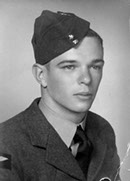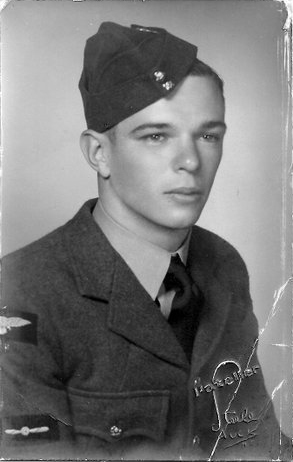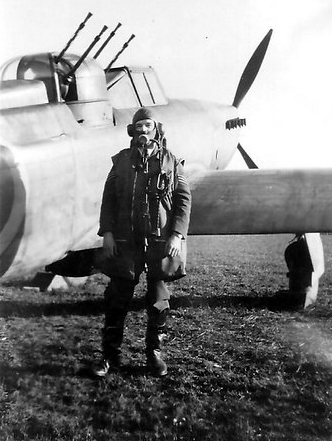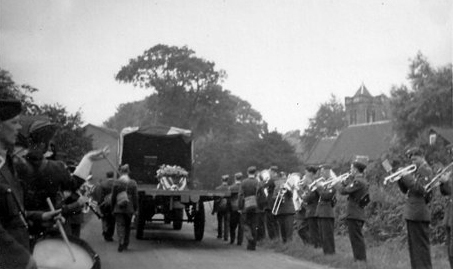
 Name : Ivan Norton Robinson
Name : Ivan Norton Robinson
Rank : Sergeant - Air Gunner, No.96 Squadron
Ser. No. : T.B.C.
Dates at Cranage : 10 Feb 1941 - 22 July 1941
When I started this web site I received numerous files from various researchers and enthusiasts and amongst these files was a small piece about Richard Smithson, a Boulton Paul Defiant pilot with No.96 Squadron. The piece told one of the theories on how Pilot Officer Smithson and his gunner, Sergeant Ivan Robinson were killed, it was thought that they were ‘show boating’ to two nurses that they knew and as a result, the Defiant crashed into the hillside, killing both men instantly. While some may see this as a ‘romantic’ wartime story it appears that after much time spent on research that this was most definitely not the case.
The piece below was sent to me by Ivan's niece, Gayle Cotter and explains a bit about Ivan’s time in the R.N.Z.A.F. and how he came to be in 96 Squadron at R.A.F. Cranage.
 Ivan Norton Robinson was born in 1921 in Wanganui, a small city on the west coast of the North Island of New Zealand. In 1938 the family moved to Auckland, where Ivan joined the Territorials and began work as a junior lifter at the NZ Railway Workshops. Apparently he was very keen to become a pilot and applied a couple of times - unsuccessfully - to join the R.N.Z.A.F. When WW2 began in September 1939 however, he was accepted for air gunner training in the R.N.Z.A.F. and was sent to the Ground Training School in Levin initially, then to Ohakea Air Force Base. By March 1940 he had received his air gunner's badge and was informed that he would be stationed in England with the R.A.F.
Ivan Norton Robinson was born in 1921 in Wanganui, a small city on the west coast of the North Island of New Zealand. In 1938 the family moved to Auckland, where Ivan joined the Territorials and began work as a junior lifter at the NZ Railway Workshops. Apparently he was very keen to become a pilot and applied a couple of times - unsuccessfully - to join the R.N.Z.A.F. When WW2 began in September 1939 however, he was accepted for air gunner training in the R.N.Z.A.F. and was sent to the Ground Training School in Levin initially, then to Ohakea Air Force Base. By March 1940 he had received his air gunner's badge and was informed that he would be stationed in England with the R.A.F.
For a teenager of limited means and living in an isolated part of the world at that time, the opportunity to travel overseas while serving his country at war would have seemed quite an adventure. Ivan's letters to his younger sister Bev (my late mother) in Auckland provide a valuable record of his short time in England.
Ivan left New Zealand on 23 March 1940 on the SS"Akaroa" along with other servicemen, and arrived in England on 9 May. By 3 June he was at Duxford with No. 264 Squadron and began night flying as an air gunner on Boulton Paul Defiants. However, within a few days (11 June) Ivan and his pilot, P/O George Hutcheson, were involved in an accident. After air to air firing at Sutton Bridge their engine failed and P/O Hutcheson attempted a forced landing back at their airfield. Ivan wrote that "we suddenly went straight down and it was too low for a parachute so I just hung on and hoped for the best until I passed out . . . I am still here to tell the tale but my pilot is not". Tragically, while Ivan escaped with a fractured jaw, George Hutcheson was killed. "I am very sorry as he was a decent chap".
Ivan spent the next three months in hospital "sucking a rubber tube" (his diet was liquid only) while his jaw healed. He was well cared for and he enjoyed the company of other patients at the hospital, but was impatient to return to active duty. In mid September Ivan returned to his squadron, this time at Kirton-in-Lyndsey, where he was informed that he was now a Sergeant. His letters also mention Biggin Hill, Rochford and Gravesend during his time with No. 264 Squadron.
 On 10 February 1941 Ivan joined No. 96 Squadron at Cranage and continued defensive night flying as an air gunner on Defiants. After a few weeks he was teamed with P/O Richard Smithson. His serious accident several months before did not seem to have dampened his enthusiasm for air combat whatsoever, and he was still hoping to be accepted for pilot training eventually. While Ivan would have liked "Smithy" to have been more aggressive on patrols, he had a high regard for his pilot and the two socialised together when off duty. Below is an excerpt describing one of their flights:
On 10 February 1941 Ivan joined No. 96 Squadron at Cranage and continued defensive night flying as an air gunner on Defiants. After a few weeks he was teamed with P/O Richard Smithson. His serious accident several months before did not seem to have dampened his enthusiasm for air combat whatsoever, and he was still hoping to be accepted for pilot training eventually. While Ivan would have liked "Smithy" to have been more aggressive on patrols, he had a high regard for his pilot and the two socialised together when off duty. Below is an excerpt describing one of their flights:
“The night before last Smithy and I chased 4 huns (sic). I got in a departing burst at two in formation as they were leaving us behind and shortly afterwards I spotted a Dornier. We were out over the sea and only 50ft up. I told Smithy to bank and I got in two good bursts but I was not in a position to hit a vital spot and the bullets just went into the fuselage. However each time there was a bright flash which blinded me so something was happening. We were only 50ft away from him too but not in a good position. I asked Smithy to bank again and we lost him then and did not see him again. We had to find a drome then and it was mighty dark. However we managed and it was OK. It was one of the most exciting flights I've had and I think he came down about half an hour later but the Ack Ack say they fired at him so we only get half anyway.”
On the afternoon of 22 July 1941 Ivan and Richard took off in the recently repaired Defiant T4071 for a test flight. The plane was seen to circle around Eddisbury Hill near Cranage at a very low altitude. It began a second circuit, but this time the plane went into a left hand turn, then went into a dive and crashed into the hill. The plane burst into flames on impact but apparently Ivan died instantly from multiple injuries. On this website Richard's nephew Dave Smithson has described the controversy surrounding this accident. It is curious that Ivan's and Richard's families were given different versions of the events that led to the crash. On the other side of the world my late grandmother was informed that the crash was due to pilot error, that the aircraft had been previously tested and was fit for flight, while Richard's family in England were led to believe that Richard had died heroically while on night patrol. Dave Smithson has carried out a great deal of research into the crash and I would agree with his opinion that the aircraft was almost certainly faulty. I can't remember my mother or grandmother ever mentioning Ivan's pilot or the fact that the official cause of the crash was pilot error, so presumably they eventually accepted that in wartime death was never far away for those involved, whatever the cause. But he was sadly missed - there was always a photo of Ivan in his R.N.Z.A.F. uniform displayed in my parent's home.
 During his time in England Ivan and his close R.N.Z.A.F. friends sometimes stayed with Mrs C.J. Nicholls in Exeter while they were on leave. Mrs Nicholls wrote to my grandmother after the accident and it was clear that this kind, elderly lady - who opened her home to young servicemen far from home - was very fond of Ivan. The feeling was mutual - he referred to her as his 'War Mother" in one of his letters.
During his time in England Ivan and his close R.N.Z.A.F. friends sometimes stayed with Mrs C.J. Nicholls in Exeter while they were on leave. Mrs Nicholls wrote to my grandmother after the accident and it was clear that this kind, elderly lady - who opened her home to young servicemen far from home - was very fond of Ivan. The feeling was mutual - he referred to her as his 'War Mother" in one of his letters.
Ivan is buried in St John the Evangelist churchyard in Byley, close to the land once occupied by Cranage Airfield. He was a courageous and popular young man who will never be forgotten by his family in New Zealand.
All material on the web site is covered by copyright © 2010 - 2016